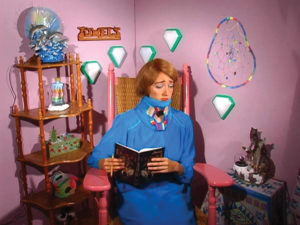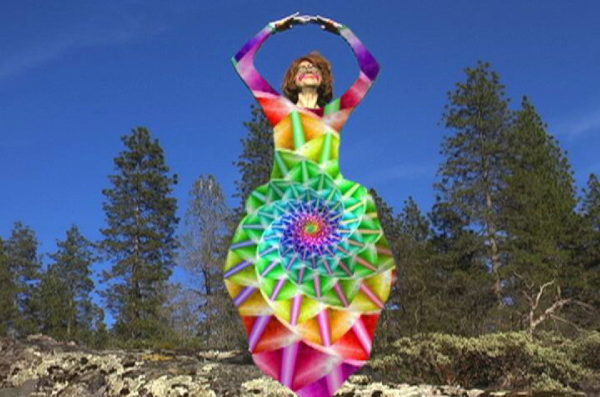There is a taut psychological oscillation throughout “Journeys Out of the Body,” Shana Moulton’s current solo exhibition at the Museum of Fine Arts, St. Petersburg. It could vaguely be heard in the opening night crowds that shuffled through the galleries as people occasionally let out hushed chuckles, at once amused and uneasy. Swift swings between blissful optimism and physical dread are perhaps more often products of church sermons or guided mindfulness meditation sessions. However, the entire exhibition seems to quiver between the two and it’s contagious like a yawn or an itch.
“Journeys Out of the Body” is notable for Moulton in several respects: it’s her first U.S. museum solo exhibition, the first time her “Whispering Pines” series has been shown in its entirety, and her largest exhibition to date. In terms of the number of video works (15 in addition to the sculptures and installations) and especially their sum duration, the exhibition is overwhelming, but not off-putting. Rather, it serves as a point of entry into the hypochondriacal obsessions of Cynthia, an alter-ego Moulton introduced in “Whispering Pines,” and features in nearly every piece of the exhibition.
Moulton’s videos are fairly narrative with Cynthia in perpetual pursuit of physical and spiritual self-improvement. Her earnestness and optimism rarely wane, but are also only a thin coat over a corresponding anxiety. For example, in Mindplace Thoughtstream (2014), Shakira dances through a forest to the probiotic benefits of Activia as Cynthia unabashedly follows suit. Shakira’s music eventually gives way to a voice-over TED talk by neuroanatomist Jill Bolte Taylor detailing an out-of-body-like experience. It becomes apparent that Cynthia is fruitlessly searching for relief from not only IBS or carpal tunnel syndrome, but the heavier general anxieties of being/having a physical body.

Shana Moulton, Whispering Pines 3, 2007. ©Shana Moulton, courtesy of the Museum of Fine Arts, St. Petersburg, Florida.
Objects—prescription drugs, wellness industry goods, new age knick-knacks—are integral to Cynthia’s endless journey of self-transformation. Seen through the quasi-mystical glow of each video and installation, these objects take on a near spiritual significance. Pillboxes function like heptagonal reliquaries and used Bioré Pore Strips as a means of divination.
This holds true in Molton’s use of logos and brand imagery. In Mindplace Thoughtstream as well as the video and installation Repetitive Stress Injuries (2008) the logos of health and beauty brands swoop through the screen. The logos, such as those of Oil of Olay or Luna Bar, are predominantly the curvy and exaggerated bodily forms of women. Decontextualized in the video, these late-capitalist fetish objects begin to resemble pastel and vectorized Venuses of Willendorf. Though these works can be read as a subtle chastisement of the health and beauty industry, they perhaps also point to the intense and anxious devotion paid to the pursuit of wellness.
Moulton portrays Cynthia, of course, as a caricature; however, the tenuousness of Cynthia’s role as master of her own body is palpable and distressingly familiar. Shana Moulton acutely engages an alternating sense of psycho-physical hope and despair. As this is amplified and complicated by a growing health industry and life on the internet, her work becomes increasingly poignant.


